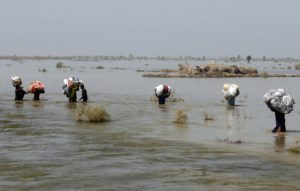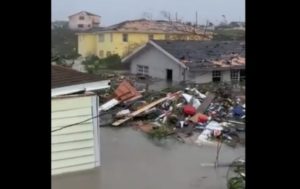Was Sandy a Wake-Up Call?
We've had two once-in-a-century storms within the span of a decade. Will we finally get the message?We’ve had two once-in-a-century storms within the span of a decade. Hurricane Sandy seems likely to be the second-costliest storm in U.S. history, behind Hurricane Katrina. Lower Manhattan is struggling to recover from an unprecedented flood and the New Jersey coast is smashed beyond recognition.
Will we finally get the message?
How, at this point, can anyone deny the scientific consensus about climate change? The traditional dodge — that no one weather event can definitively be attributed to global warming — doesn’t work anymore. If something looks, walks and quacks like a duck, it’s a duck. Especially if the waterfowl in question is floating through your living room.
For decades now, researchers have been telling us that one of the effects of climate change would be to make the weather more volatile and violent. Well, here we are.
And here we will remain, perhaps for the rest of our lives. Since the beginning of the Industrial Revolution, when humans began burning fossil fuels in earnest, the concentration of heat-trapping carbon dioxide in the atmosphere has increased by an incredible 40 percent. We have altered the composition of the air.
Even if we halted all carbon emissions tomorrow, elevated levels of atmospheric carbon dioxide — and their effect on the weather — would persist for between 50 and 200 years, according to the Environmental Protection Agency.
Of course, we won’t stop spewing carbon into the air tomorrow or anytime soon. The global economy runs on carbon, and changing this reality will take many years and a few technological breakthroughs. Even if the United States joins Europe in taking climate change seriously and trying to do something about it, China is now the world’s largest carbon emitter — and keeps adding coal-fired power plants at an alarming rate.
I have to believe that eventually we’ll get the carbon situation under control. But emissions will get worse before they get better, and so one of the biggest questions facing the next president — and his successors — will be how we should best adapt to the new climatological and meteorological order.
Some environmentalists are wary of talking about adapting to climate change, fearing this provides an out for those reluctant to engage with the difficult problem of moving to cleaner energy sources. The truth, though, is that both conversations desperately need to take place.
The economic costs alone are enough to concentrate the mind. Hurricane Katrina did more than $100 billion in damage to New Orleans and the Gulf Coast. The cost of Hurricane Sandy seems likely to exceed $50 billion.
Those sums are not big enough to have a serious impact on the U.S. economy. But consider that the total insured value of property along the Gulf and Atlantic coasts is nearly $9 trillion, according to a 2008 study by AIR Worldwide, a risk-management consulting firm. Imagine the costs if, a few years from now, the next once-in-a-century superstorm slams into downtown Miami or turns Houston into one gigantic bayou.
The coastlines are the most densely populated parts of the country, with about half of all Americans living within 50 miles of the sea, according to the Census Bureau. About three of every 10 Americans live in coastal counties, including 41 million on the Atlantic seaboard and 14 million on the fast-growing Gulf Coast — the areas most vulnerable to Katrina-style and Sandy-style storms.
Given sea-level rise, storm surges may reach levels that seemed unimaginable, as happened this week in Lower Manhattan. Cities are going to have to consider building huge — and hugely expensive — surge barriers similar to the ones that protect Rotterdam and London. For New York, this seems a no-brainer. What price is too high to protect one of the great financial and cultural centers of the world?
Do we need new and more restrictive building codes for vulnerable barrier islands, such as those along the Jersey shore? If so, then surely we must need similar measures farther south, where hurricane impacts are more likely. Or were more likely. I’m not sure we even know what’s likely anymore.
These may be state and local issues, but tackling them will require federal involvement. Hurricane Sandy was ultimately a national disaster, and it is Washington that will foot much of the recovery bill.
Climate change is a national challenge. Ignoring it is not a solution. Pretending it isn’t happening will not make it stop.
Eugene Robinson’s e-mail address is eugenerobinson(at)washpost.com.
© 2010, Washington Post Writers Group
Your support matters…Independent journalism is under threat and overshadowed by heavily funded mainstream media.
You can help level the playing field. Become a member.
Your tax-deductible contribution keeps us digging beneath the headlines to give you thought-provoking, investigative reporting and analysis that unearths what's really happening- without compromise.
Give today to support our courageous, independent journalists.









You need to be a supporter to comment.
There are currently no responses to this article.
Be the first to respond.